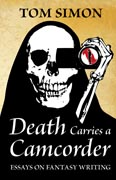After the sack of Eremis, the children of Morak were never again united in one cause. For it was the Destroyer who had brought them together by the thoughts that he put into their hearts; and they had failed him. As a weapon, they were too blunt and brittle for his purpose. They had destroyed the city, but not the nation; many of the Färinoth were slain, but many yet lived, though scattered over many lands, and they would not be taken at unawares again. From that time the Destroyer cast aside the creatures he had tempted into his service, and minded them no more. Not one of the promises by which he had seduced them was ever kept.
When they saw how they had been cheated, the Morakh loosed all the rage and violence that was bred into their nature. The empty city they smashed into rubble, defiling the ground and cursing all the land of Ereph. No child of Dân dwelt ever again by the waters of Drath Erem, and the River of Spirit ran untravelled to the sea. In later ages a few rash wanderers dared disturb the sleeping wrath of Eremis, and if ever they returned to the lands of the living, they brought back tales of ghosts and ghouls, fell spirits and foul lights, and their faces were marred by a horror that they could neither tell nor forget. Even birds and beasts kept far away from that unclean place.
Few of the Morakh were slain in the taking of the city, but many in the aftermath. It is told in the Gremni that a swift winter and a hard fell then upon the Southern lands; and many more of the host of Ghrenduz perished of cold and hunger, for they had assembled in haste and without thought of provision. Some have seen in this the Destroyer’s own hand, a final stroke of contempt for his broken weapon, sending deep snows and howling winds from the edge of the Void. It was long believed that all the kindred of Morak had perished in that winter; but it was not so. A few survivors there must have been, for they returned long after to trouble the world again.
[Read more…]







Recent Comments